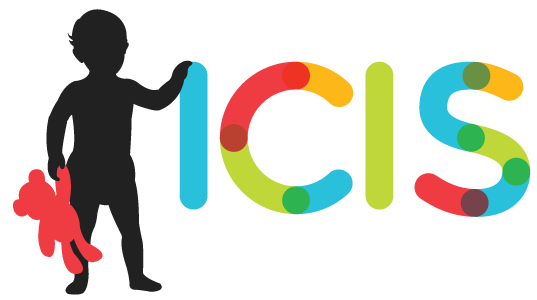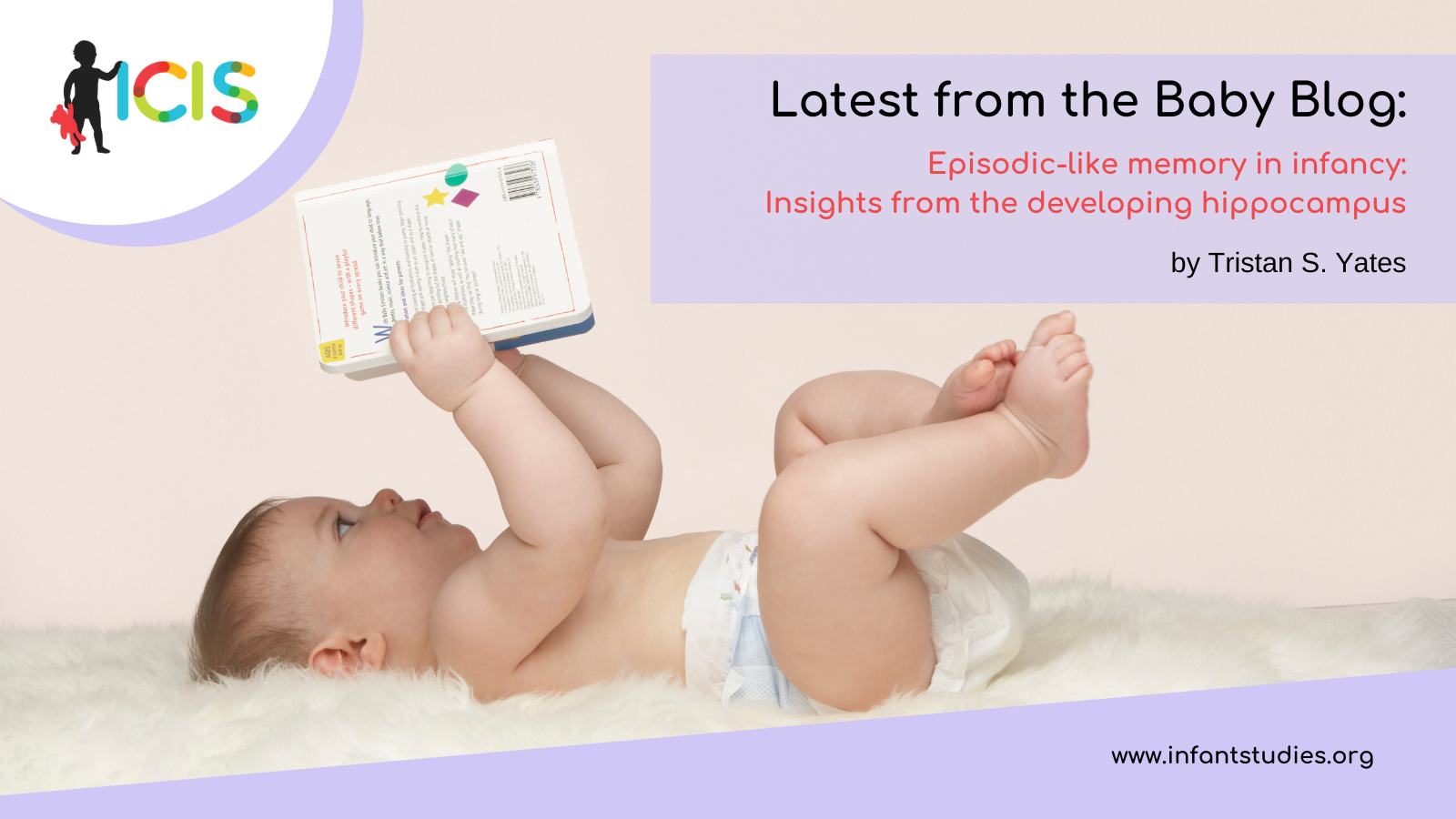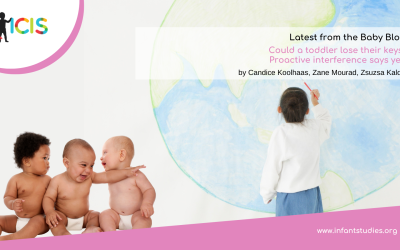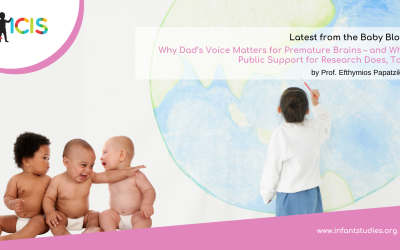On visits to my mother’s house, it is inevitable that we look through baby pictures, a tradition that has grown increasingly common since I began my research into memory development. I know the stories behind many of these pictures, mostly through my mother. This past winter, fixing her VHS player offered a new opportunity for reminiscing. The first unlabeled tape we played was of the day my twin sister and I arrived home from the hospital—the beginning of our life stories, and yet a day we could not remember.
Why are we so fascinated by our earliest memories? Memories for specific events in our lives (episodic memories) form the basis of our personal identities, and shape how we see ourselves in the world1. Despite the immense amount of learning in the first few years of life, most of us report our first specific memories from around 3 to 4 years of age2,*. This lack of specific memories from infancy and toddlerhood (termed infantile amnesia by Freud3) has been the subject of both scientific debate4,5 and public interest6. More than just a philosophical question, understanding whether and how infants form memories for specific events has important implications for understanding why some early experiences have profound impacts on later development7. Excitingly, recent advances in neuroimaging methods in infants and young children8 are allowing us to probe the emergence and contents of early life memories.

Pictures can transport our family members back in time to specific moments from our infancy, even though our memories for those experiences are lost. Neuroimaging, and awake infant fMRI in particular, may help reveal the mechanisms by which we learn, remember, and forget our earliest experiences.
Infantile amnesia and brain development
Many theories of infantile amnesia9–11 highlight developing brain systems, particularly the hippocampus12, to explain why specific early life memories do not persist into adulthood. The hippocampus is critical for the encoding and retrieval of episodic memories in adults13,14 and undergoes dramatic structural development in early life15. However, structural immaturity does not preclude function; many brain regions develop well into adolescence16 and are nonetheless associated with cognitive functions in childhood17. This leads to the question of whether specific memories from infancy are ‘lost’ during storage or retrieval, or were never formed in the hippocampus in the first place18. Elegant research with rodents19–22 has begun to address this question, showing that memories for specific experiences are formed in the hippocampus in infancy and can be recalled via reactivating neurons with optogenetics in adulthood21,22. Recent innovations in awake infant functional magnetic resonance imaging (fMRI)23,24 has allowed translation of these findings to human infants.
Hippocampal contributions to infant memory
In our recent study25, we scanned 26 infants aged 4 months to 2 years while they were awake and performing a memory task. We designed a task to examine ‘episodic-like’ memory† for specific experiences tested at a delay outside of the window of working memory. In brief, infants viewed pictures of previously-unseen faces, objects, and scenes on top of a green kaleidoscopic background, and then saw the same picture an average of a minute later alongside a new picture from the same category in a visual paired comparison test. Using the logic of the ‘subsequent memory’ paradigm26,27, we sorted encoding trials (i.e., the first time that infants saw a picture) based on infants’ looking time between the old and new picture at test. Hippocampal activity, particularly in the posterior subregion, was higher when infants first saw a picture that they would later show a familiarity preference for at test; moreover, infants with higher average familiarity preferences showed stronger memory-related hippocampal activity. Interestingly, there was age-related change, such that memory-related hippocampal activity was reliable only in infants older than one year of age. Because visual activation was reliable and not different between younger and older infants, this age-related change was not solely due to inadequate power to detect effects in younger infants. These results suggest that the human infant hippocampus is capable of encoding memories for specific experiences by at least the end of the first year of life, constraining theories of infantile amnesia based on deficits of memory encoding.
An early capacity for episodic-like memory encoding
The idea that infants are capable of forming specific memories early in life fits with a vast literature showing sophisticated episodic-like memory behaviors in infancy28. Infant memory has been observed in tasks such as the visual paired comparison test29, the mobile conjugate reinforcement paradigm30, the deferred imitation paradigm31, and the relational binding task32, each of which exhibit one or more elements of episodic-like memory (e.g., one-shot learning, long-term retention, flexible associations, spatial/temporal context binding). One recent review33 proposed that episodic-like memory may be even more ubiquitous in infancy than previously thought, given that paradigms that are not designed to study memory (e.g., surprise-induced learning34 and social cognition35) nonetheless require rapid and flexible encoding of events over extended delays.
If episodic-like memories can be formed in infancy, even in the hippocampus, why then, do they not persist into adulthood? We hypothesize that mechanisms of infantile amnesia may be more related to post-encoding processes, such as how infant memories are stored and/or later retrieved. Here, the rodent literature is quite suggestive. Neurogenesis in the hippocampus, which is prominent in early life10,19,36, can induce forgetting by destabilizing memory engrams or altering their connections, suggesting that long term storage of infant memories may be disrupted. At the same time, infant memories can be recovered in adulthood through reminders20 and optogenetic techniques21,22, suggesting that some infant memories still exist in the brain, even if normally inaccessible for retrieval. Of course, memory encoding may still be impoverished in infancy. Indeed, we only tested memory for individual items and not relations (which engage the hippocampus more in adults37), and hippocampal activity in our study tracked with familiarity preferences, which have been traditionally associated with partial or incomplete encoding38. Assessing infant memories over time and across different paradigms will help reveal how different stage(s) of memory contribute to infantile amnesia.
Balancing between learning systems in early life
Hippocampal involvement in memory encoding in our study emerged around 9 to 12 months of age, which has been highlighted as an important time for memory development39,40. Interestingly, this is notably later than hippocampal involvement in statistical learning (the ability to extract regularities from the environment), which we previously showed in infants aged 3 to 24 months41. Different developmental trajectories for statistical learning and episodic-like memory function in the infant hippocampus are consistent with anatomical development of the monosynaptic (entorhinal cortex to CA1 subfield) and trisynaptic (entorhinal cortex to dentate gyrus, CA3, and CA1) hippocampal pathways15, which have been computationally linked to statistical learning and episodic memory, respectively42. Subregion analyses also mapped onto known anatomical differences in the monosynaptic and trisynaptic pathways43, with statistical learning effects strongest in the anterior (vs. posterior) hippocampus and memory encoding effects strongest in the posterior (vs. anterior) hippocampus.
Why would the hippocampus exhibit different developmental trajectories for statistical learning versus memory encoding? An ecological account proposes that developing organisms are adapted to meet their current environmental niche44. When one has little prior knowledge (as is the case for an infant), it may be advantageous to extract general patterns in the environment before then encoding specific information45,46. In other words, statistical learning may supply a ‘baseline’ from which novel information can then be compared47. Just like perception starts broad and then narrows over development48, cognitive processes like attention and learning may operate over broad (or ‘general’) information†† before narrow (or ‘specific’) information49. This may be adaptive for making predictions and guiding future behavior in a dynamic environment. At present, this is mostly theoretical, and longitudinal research is necessary for linking the emergence of statistical learning and episodic memory in the infant hippocampus. Nonetheless, these initial findings from awake infant fMRI are contributing to our understanding of how the infant brain may balance between learning systems in early life.
Looking forward
As much as my mother wishes I could remember our extravagant first birthday party, my specific memories from early life are sparse. But I still extracted meaning from the patterns in my early experiences50, such as the fun we had and the love that was ever present. Awake infant fMRI is helping to reveal how we represent early experiences, with recent findings suggesting that the infant hippocampus is capable of forming episodic-like memories, even if such memories are later lost. This may constrain theories of infantile amnesia and inform our understanding of learning systems in early life. More broadly, this work highlights the promise of awake infant fMRI for characterizing mechanisms underlying cognitive development51 and contributing to our understanding of what it is like to be a baby.
Footnotes
*If you would like to contribute to our study of people’s earliest memories, please consider taking this anonymous, 5 minute survey: https://yalesurvey.ca1.qualtrics.com/jfe/form/SV_0IJ7NSrA1oYYNeK
†Traditional theories define episodic memory as a type of declarative memory requiring explicit, conscious access — something that cannot be assessed in preverbal infants
††General representations can arise from insufficient encoding and forgetting of details (‘fuzzy’ representations), or the abstraction of commonalities over multiple distinct episodes, which may exhibit distinct developmental trajectories52
References
- Nelson, K. & Fivush, R. The emergence of autobiographical memory: A social cultural developmental theory. Psychological Review 111, 486–511 (2004).
- Akhtar, S., Justice, L. V., Morrison, C. M. & Conway, M. A. Fictional first memories. Psychological Science 29, 1612–1619 (2018).
- Freud, S. Psychopathology of Everyday Life. (W. W. Norton & Company, 1966).
- Nadel, L. & Zola-Morgan, S. Infantile amnesia: A neurobiological perspective. in Infant Memory (ed. Moscovitch, M.) 145–172 (Springer US, Boston, MA, 1984).
- Alberini, C. M. & Travaglia, A. Infantile amnesia: A critical period of learning to learn and remember. Journal of Neuroscience 37, 5783–5795 (2017).
- Daniel, A. Why don’t we remember being babies? Brain scans reveal new clues. NPR (2025).
- Li, S., Callaghan, B. L. & Richardson, R. Infantile amnesia: Forgotten but not gone. Learning & Memory 21, 135–139 (2014).
- Turk-Browne, N. B. & Aslin, R. N. Infant neuroscience: How to measure brain activity in the youngest minds. Trends in Neurosciences 47, 338–354 (2024).
- Bauer, P. J. Constructing a past in infancy: A neuro-developmental account. Trends in Cognitive Sciences 10, 175–181 (2006).
- Josselyn, S. A. & Frankland, P. W. Infantile amnesia: A neurogenic hypothesis. Learning & Memory 19, 423–433 (2012).
- Gómez, R. L. & Edgin, J. O. The extended trajectory of hippocampal development: Implications for early memory development and disorder. Developmental Cognitive Neuroscience 18, 57–69 (2016).
- Bevandić, J. et al. Episodic memory development: Bridging animal and human research. Neuron 112, 1060–1080 (2024).
- Scoville, W. B. & Milner, B. Loss of recent memory after bilateral hippocampal lesions. Journal of Neurology, Neurosurgery & Psychiatry 20, 11–21 (1957).
- Squire, L. R. Memory and the hippocampus: A synthesis from findings with rats, monkeys, and humans. Psychological Review 99, 195–231 (1992).
- Lavenex, P. & Banta Lavenex, P. Building hippocampal circuits to learn and remember: Insights into the development of human memory. Behavioural Brain Research 254, 8–21 (2013).
- Gogtay, N. et al. Dynamic mapping of human cortical development during childhood through early adulthood. Proceedings of the National Academy of Sciences 101, 8174–8179 (2004).
- Casey, B., Tottenham, N., Liston, C. & Durston, S. Imaging the developing brain: What have we learned about cognitive development? Trends in Cognitive Sciences 9, 104–110 (2005).
- Ellis, C. T. & Turk-Browne, N. B. Infant fMRI: a model system for cognitive neuroscience. Trends in Cognitive Sciences 22, 375–387 (2018).
- Akers, K. G. et al. Hippocampal neurogenesis regulates forgetting during adulthood and infancy. Science 344, 598–602 (2014).
- Travaglia, A., Bisaz, R., Sweet, E. S., Blitzer, R. D. & Alberini, C. M. Infantile amnesia reflects a developmental critical period for hippocampal learning. Nature Neuroscience 19, 1225–1233 (2016).
- Guskjolen, A. et al. Recovery of “lost” infant memories in mice. Current Biology 28, 2283-2290.e3 (2018).
- Power, S. D. et al. Immune activation state modulates infant engram expression across development. Science Advances 9, eadg9921 (2023).
- Ellis, C. T. et al. Re-imagining fMRI for awake behaving infants. Nature Communications 11, 4523 (2020).
- What infant fMRI is revealing about the developing mind. The Transmitter: Neuroscience News and Perspectives https://www.thetransmitter.org/cognitive-neuroscience/what-infant-fmri-is-revealing-about-the-developing-mind/ (2025).
- Yates, T. S. et al. Hippocampal encoding of memories in human infants. Science 387, 1316–1320 (2025).
- Wagner, A. D. et al. Building memories: Remembering and forgetting of verbal experiences as predicted by brain activity. Science 281, 1188–1191 (1998).
- Brewer, J. B., Zhao, Z., Desmond, J. E., Glover, G. H. & Gabrieli, J. D. E. Making memories: Brain activity that predicts how well visual experience will be remembered. Science 281, 1185–1187 (1998).
- Bauer, P. J., Souci, P. S. & Pathman, T. Infant memory. WIREs Cognitive Science 1, 267–277 (2010).
- Pascalis, O., de Haan, M., Nelson, C. A. & de Schonen, S. Long-term recognition memory for faces assessed by visual paired comparison in 3- and 6-month-old infants. Journal of Experimental Psychology: Learning, Memory, and Cognition 24, 249–260 (1998).
- Rovee-Collier, C. K., Sullivan, M. W., Enright, M., Lucas, D. & Fagen, J. W. Reactivation of infant memory. Science 208, 1159–1161 (1980).
- Meltzoff A.N. What infant memory tells us about infantile amnesia: Long-term recall and deferred imitation. Journal of Experimental Child Psychology 59, 497–515 (1995).
- Richmond, J. & Nelson, C. A. Relational memory during infancy: Evidence from eye tracking. Developmental Science 12, 549–556 (2009).
- Behm, L., Turk-Browne, N. B. & Kibbe, M. M. The ubiquity of episodic-like memory during infancy. Trends in Cognitive Sciences 0, (2025).
- Stahl, A. E. & Feigenson, L. Observing the unexpected enhances infants’ learning and exploration. Science 348, 91–94 (2015).
- Southgate, V., Chevallier, C. & Csibra, G. Seventeen-month-olds appeal to false beliefs to interpret others’ referential communication. Developmental Science 13, 907–912 (2010).
- Ryan, T. J. & Frankland, P. W. Forgetting as a form of adaptive engram cell plasticity. Nature Reviews Neuroscience 23, 173–186 (2022).
- Davachi, L. Item, context and relational episodic encoding in humans. Current Opinion in Neurobiology 16, 693–700 (2006).
- Hunter, M. A. & Ames, E. W. A multifactor model of infant preferences for novel and familiar stimuli. in Advances in infancy research, Vol. 5. 69–95 (Ablex Publishing, Westport, CT, US, 1988).
- Morgan, K. & Hayne, H. Age-related changes in visual recognition memory during infancy and early childhood. Developmental Psychobiology 53, 157–165 (2011).
- Nelson, C. A. The ontogeny of human memory: A cognitive neuroscience perspective. Developmental Psychology 31, 723–738 (1995).
- Ellis, C. T. et al. Evidence of hippocampal learning in human infants. Current Biology 31, 3358-3364.e4 (2021).
- Schapiro, A. C., Turk-Browne, N. B., Botvinick, M. M. & Norman, K. A. Complementary learning systems within the hippocampus: A neural network modelling approach to reconciling episodic memory with statistical learning. Philosophical Transactions of the Royal Society B: Biological Sciences 372, 20160049 (2017).
- Malykhin, N. V., Lebel, R. M., Coupland, N. J., Wilman, A. H. & Carter, R. In vivo quantification of hippocampal subfields using 4.7 T fast spin echo imaging. NeuroImage 49, 1224–1230 (2010).
- Rovee-Collier, C. & Cuevas, K. Multiple memory systems are unnecessary to account for infant memory development: An ecological model. Developmental Psychology 45, 160–174 (2009).
- Keresztes, A., Ngo, C. T., Lindenberger, U., Werkle-Bergner, M. & Newcombe, N. S. Hippocampal maturation drives memory from generalization to specificity. Trends in Cognitive Sciences 22, 676–686 (2018).
- Ramsaran, A. I., Schlichting, M. L. & Frankland, P. W. The ontogeny of memory persistence and specificity. Developmental Cognitive Neuroscience 36, 100591 (2018).
- Frost, R. et al. Statistical learning subserves a higher purpose: Novelty detection in an information foraging system. Psychological Review (2025).
- Maurer, D. & Werker, J. F. Perceptual narrowing during infancy: A comparison of language and faces. Developmental Psychobiology 56, 154–178 (2014).
- Forest, T. A., Schlichting, M. L., Duncan, K. D. & Finn, A. S. Changes in statistical learning across development. Nature Reviews Psychology 2, 205–219 (2023).
- Tottenham, N. & Vannucci, A. Attachment as prediction: insights from cognitive and developmental neuroscience. Current Directions in Psychological Science 34, 195–206 (2025).
- Yates, T. S., Ellis, C. T. & Turk-Browne, N. B. The promise of awake behaving infant fMRI as a deep measure of cognition. Current Opinion in Behavioral Sciences 40, 5–11 (2021).
- Reyna, V. F. & Brainerd, C. J. Fuzzy-trace theory: An interim synthesis. Learning and Individual Differences 7, 1–75 (1995).
About the Author

Tristan S. Yates, Ph.D.
Postdoctoral Research Scientist, Columbia University
Dr. Tristan Yates is a postdoctoral research scientist in the Developmental Affective Neuroscience Lab (PI: Dr. Nim Tottenham) at Columbia University. She received a B.S. in neuroscience from Emory University and a Ph.D. in cognitive psychology from Yale University (PI: Dr. Nicholas Turk-Browne). Her research focuses on the neurodevelopment of perception and memory in infancy and toddlerhood.
Bluesky: @tristansyates.bsky.social
Personal website: https://tristansyates.github.io/




